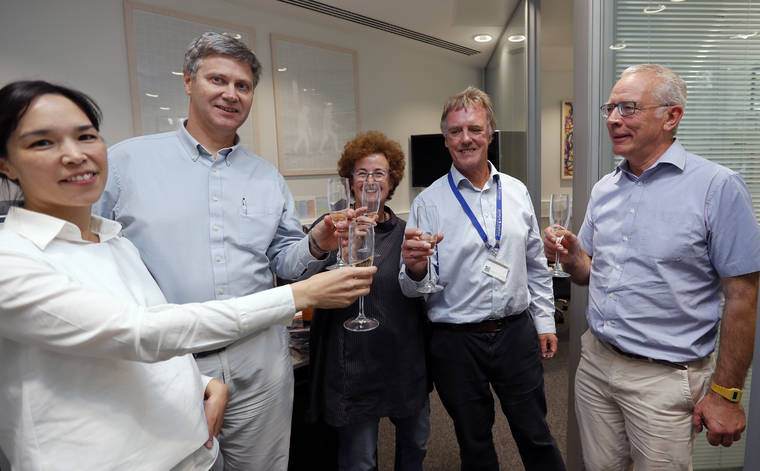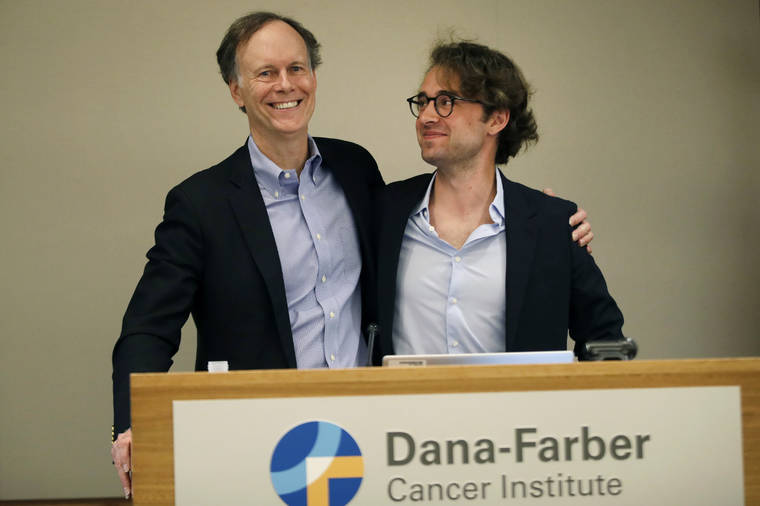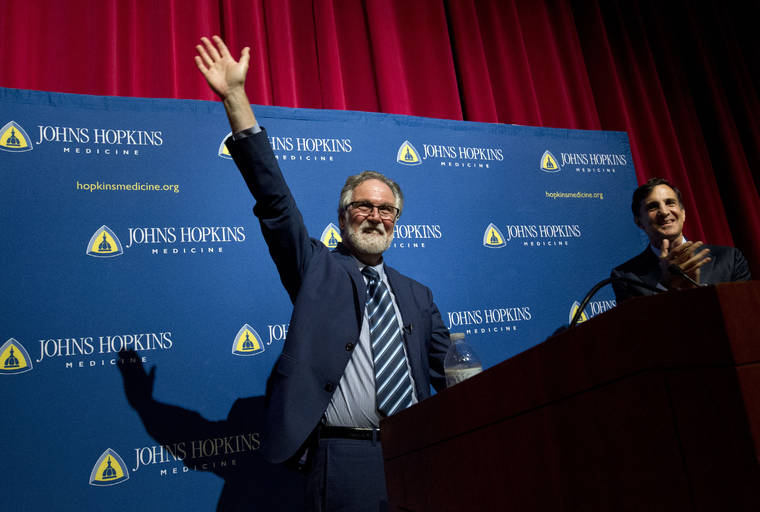3 get Nobel prize for showing how cells sense low oxygen



NEW YORK Two Americans and a British scientist won a Nobel Prize on Monday for discovering details of how the bodys cells sense and react to low oxygen levels, providing a foothold for developing new treatments for anemia, cancer and other diseases.
NEW YORK — Two Americans and a British scientist won a Nobel Prize on Monday for discovering details of how the body’s cells sense and react to low oxygen levels, providing a foothold for developing new treatments for anemia, cancer and other diseases.
Drs. William G. Kaelin Jr. of Harvard University, Gregg L. Semenza of Johns Hopkins University and Peter J. Ratcliffe at the Francis Crick Institute in Britain and Oxford University won the prize for advances in physiology or medicine.
The scientists, who worked largely independently, will share the 9 million kronor ($918,000) cash award, said the Karolinska Institute in Stockholm.
They “revealed the mechanism for one of life’s most essential adaptive processes,” the Nobel committee said.
Cells can encounter lowered oxygen not only from situations like living at high altitudes, but also from things like a wound that interferes with local blood supply. Their response triggers reactions that include producing red blood cells, generating new blood vessels and fine-tuning the immune system.
The Nobel committee said scientists are focused on developing drugs that can treat diseases by either activating or suppressing the oxygen-sensing machinery. Such manipulation could help in attacking cancer cells, experts said.
Another payoff is pills to boost production of red blood cells in anemia, which can appear in people with chronic kidney disease. One such drug has been approved in China and Japan and a filing for approval in the U.S. is expected soon, Kaelin said.
Still other potential targets include heart attack and stroke, and a condition of reduced blood flow in the limbs that can lead to amputation, the researchers said.
Kaelin, 61, said he was half-asleep when the phone rang Monday morning with the news of his award.
“I don’t usually get phone calls at 5:00 in the morning, so, naturally, my heart started racing and I could see the call was from Stockholm,” he said. “And so I think at that point I almost had an out-of-body type of experience.”
Kaelin is paid by the Howard Hughes Medical Institute, which also supports AP’s Health and Science department.
Ratcliffe, 65, said he learned the news after he was summoned out of a meeting this morning by his secretary, who had “a look of urgency.”
Trained as a kidney specialist, Ratcliffe said his research began when he and colleagues simply wanted to figure out how cells sense oxygen.
“I thought it was a definable problem and just thought we’d find out how it worked,” he said. It was about two years into their research program, which began in 1990, that they realized the discovery had much wider significance, Ratcliffe said.
“We saw that it wasn’t just cells in the kidney that know how to sense oxygen, but all cells in the body. … There are hundreds and thousands of processes the body uses to adapt to and regulate its oxygen levels.”
He said while some promising drugs have been developed, it will be years before it’s clear whether such discoveries are going to change the lives of tens of thousands.
In Baltimore, Semenza, 63, said he slept through the Nobel committee’s initial phone call. “By the time I got to the phone it was too late,” he said. He went back to sleep but was able to answer the second call from Stockholm.
He said kidney cancer may be the first malignancy in which a drug based on the prize-winning work might make chemotherapy more effective, and that he hopes many other cancers will follow.
Steven McKnight of the UT Southwestern Medical Center in Dallas noted that the process discovered by the three researchers is widespread in the animal kingdom, found even in the worm. He said the honored work is “of a heroic nature.”
Last year, James Allison of the United States and Tasuku Honjo of Japan won the 2018 Nobel Prize for Medicine for their work in immunotherapy, activating the body’s natural defense system to fight tumors.
Monday’s announcement kicked off this year’s Nobel Prizes. The physics prize will be handed out Tuesday, followed by the chemistry prize on Wednesday. This year there is a double-header for the Nobel Literature Prize — one each for 2018 and 2019 — which will be awarded Thursday. The Peace Prize will be announced on Friday.
The 2018 Nobel Literature prize was suspended after a sex abuse scandal rocked the Swedish Academy, the body that awards the literature prizes, so two prizes are being awarded this year.
The economics prize will be awarded next Monday. Officially known as the Bank of Sweden Prize in Economic Sciences in Memory of Alfred Nobel, it wasn’t created by Nobel, but by Riksbanken, Sweden’s central bank, in 1968.
The laureates will receive their awards at elegant ceremonies in Stockholm and Oslo on Dec. 10 — the anniversary of Nobel’s death in 1896.
Cheng reported from London. Associated Press writers Christopher Chester in New York, Michael Warren in Atlanta, Jan M. Olsen in Copenhagen, Denmark, and David Keyton in Stockholm contributed to this report.


